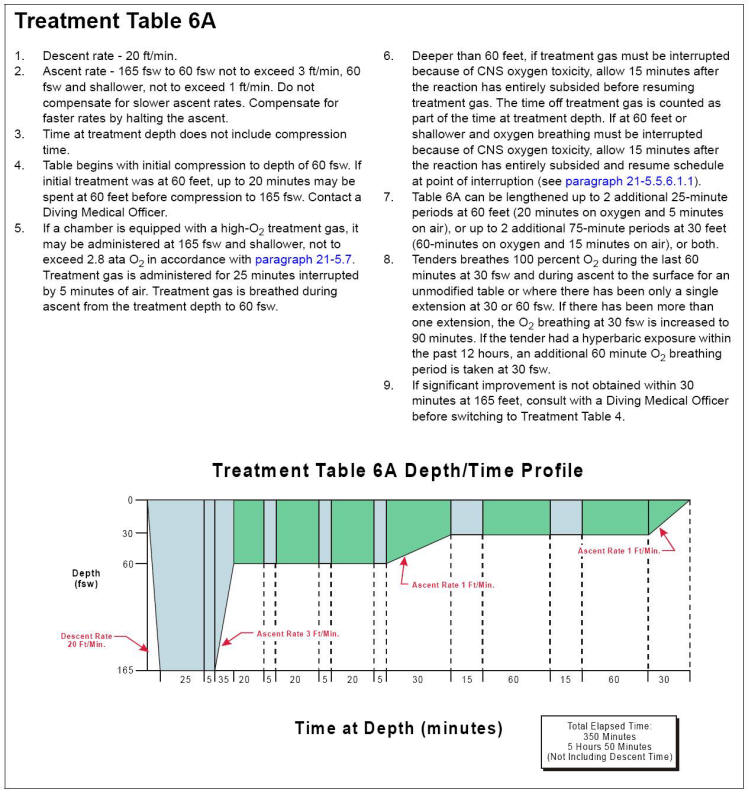Vigilance urged when treating decompression illness DCI
USN Table 6A the ‘Tender bender’ table?
July 8th 2005
Satahip, Thailand 2005 was the location for the first hyperbaric technician course run by the British Diving and Diseases Research Centre (DDRC) – An organization set up to study the effects of pressure and provides hyperbaric chamber oxygen treatment facilities and medical training for divers, technicians, nurses and doctors worldwide.
During the course, the use of the various USN tables for the treatment of decompression illness and was studied. Technician trainees also had the opportunity to visit monoplace chambers at the Queen Sirikit Naval hospital to witness the use of hyperbaric oxygen to treat skin infections that did not respond well to other techniques.
For divers, the treatment of DCI generally results in the use of two US tables. Table-6 for type I DCI-pain only symptoms and skin rashes, and USN treatment table 6A for the treatment of type II DCI-Arterial Gas Embolism. Unfortunately, table 6A is also notorious amongst for causing DCI amongst attending medical personnel!
US treatment table 6A is shown below.

Table 6A is an aggressive treatment table using a ‘descent’ to 165ft held for 30mins in an attempt to stimulate a reduction in size and collapse of inert gas bubbles present in the divers body. To prevent additional problems with DCS caused by inert gas absorption during the treatment, once the bottom time is completed a very slow ascent is made at only 3ft per minute up to 60ft where the patient begins several sessions breathing 100% Oxygen for the rest of the table.
The patient tender normally does not breath oxygen during this time because of the high risk of oxygen toxicity exhibited by personnel moving around working at such a high ppO2’s.
What is often overlooked is that in conducting a table 6A, is that both the patient and the tender carry out what is a very serious decompression dive by the time they have ascended back to 60ft, and formal decompression from this point on is essential.
It is easy to forget this important fact while conducting table 6A, in particular there is some important small print down the right hand side of the table stating that the tender must breath 100% oxygen during the last hour at 30ft and during the ascent back to the surface.
Minute by minute analysis of tenders inert gas exposure while carrying out a table 6A treatment table using a new analysis technique based on the Combined Decompression Model CDM-18 reveals some interesting results
Fig1- Tender Ascent Ceiling if following oxygen BIBS recommendations

Fig2- Tender Ascent Ceiling if forgetting to done Oxygen BIBS during last 60minutes of 30ft segment

Note: That In Fig 2 (above), If the chamber tender or any accompanying nursing personnel present inside the chamber forgets to use the Oxygen BIBS (Built In breathing System) then they ascend above the ‘ascent ceiling’ and DCI would be expected.
If nursing personnel need to leave the chamber during the treatment via the transfer lock to attend to other patients, then calculation of their decompression obligation using the USN tables is not a simple matter due to the multilevel nature and slow ascent rates used during the preceding treatment. Calculation of decompression obligation based on only a 30min exposure at 165ft would again result in DCI since it ignores the additional 35mins spent ascending to 60ft.
Conclusions
1. Vigilance in the chamber operator is essential to prevent DCI to attending personnel during treatment table 6A. In particular the chamber operator should confirm that all go onto the Oxygen BIBS and remain breathing oxygen at all times for the remaining 90mins of this table
2. That a true assessment of the decompression obligation of any attending personnel using tools such as The Combined Decompression Model profile analyser is accomplished prior to ascending any staff to surface pressure.
Steve Burton Bsc(hons) MIEE Chartered Engineer
‘*’ The ‘ascent ceiling’ is an a virtual overhead limit like the roof in a cave, that prevents decompression divers making a direct ascent to the surface during their dive. It is the reason decompression stops need to take place. Ascending above the ascent ceiling generally results in an unacceptable risk of DCI.
